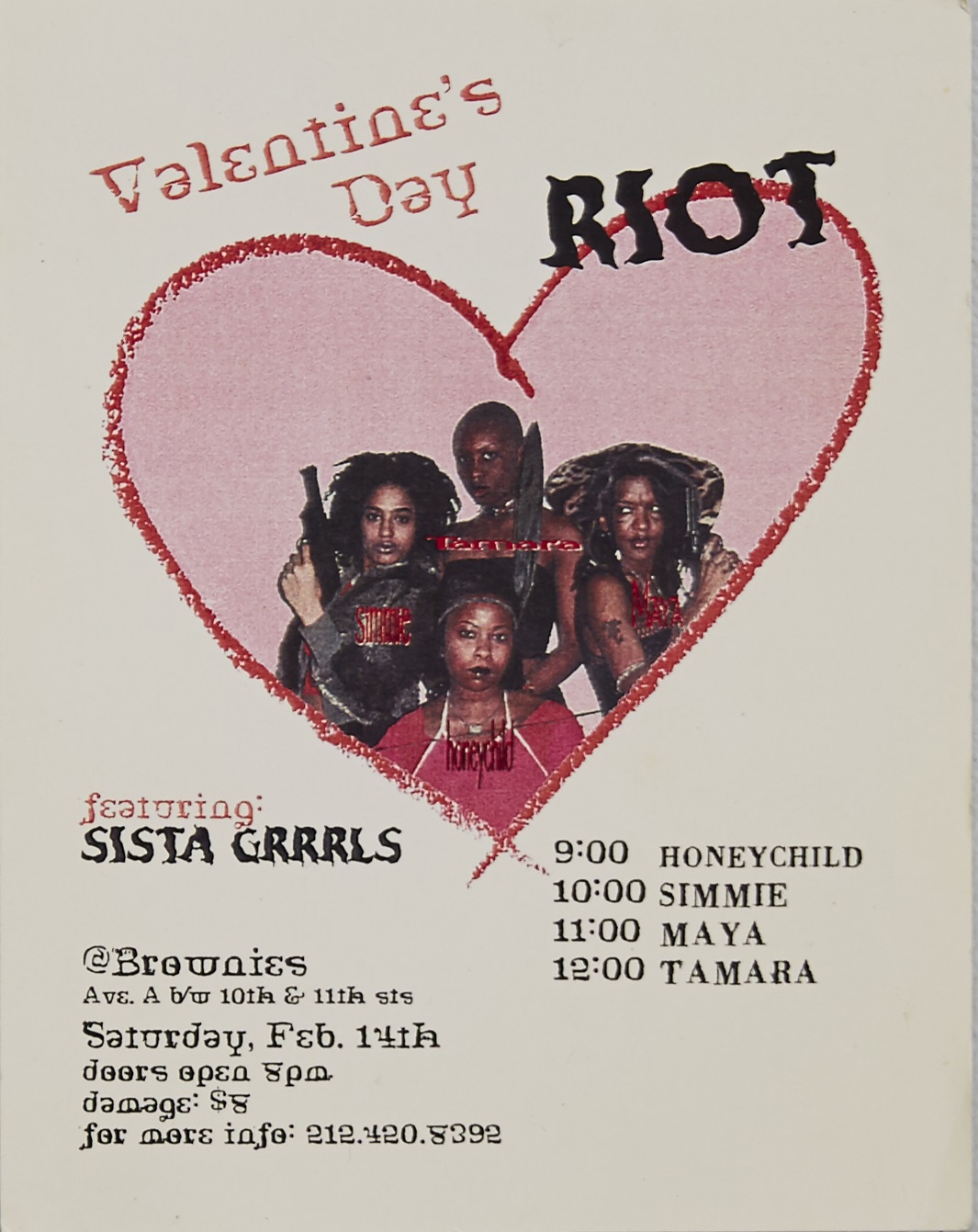Document Text
Riot grrrl is…
BECAUSE us girls crave records and books and fanzines that speak to US, that WE feel included in and can understand in our own ways
BECAUSE viewing our work as being connected to our girlfriends-politics-real lives is essential if we are gonna figure out how what we are doing impacts, reflects, perpetuates, or DISRUPTS the status quo
BECAUSE we don’t want to assimilate to someone else’s (Boy) standards of what is or isn’t “good” music or punk rock or “good” writing AND THUS need to create forums where we can recreate, destroy and define our own visions
BECAUSE we know that life is much more than physical survival and are patently aware that the punk rock “you can do anything” idea is crucial to the coming angry grrrl rock revolution which seeks to save the psychic and cultural lives of girls and women everywhere, according to their own terms, not ours
BECAUSE doing/reading/seeing/hearing cool things that validate and challenge us can help us gain the strength and sense of community that we need in order to figure out how bullshit like racism, able-bodism, ageism, speciesism, classism, thinism, sexism, anti-semitism and heterosexism figures in our own lives
BECAUSE we are angry at a society that tells us Girl = Dumb, Girl = Bad, Girl = Weak
BECAUSE I believe with my holeheartmindbody that girls constitute a revolutionary soul force that can, and will, change the world for real
Riot Grrrl Manifesto
Bikini Kill, Riot Grrrl Manifesto, 1992. Barnard Zine Library. Courtesy of Kathleen Hanna.
Background
The third wave of feminism developed in the early 1990s. Compared to the second wave of the 1960s and 1970s, the movement focused on diversity and inclusion, and worked to redefine the meaning of feminism. This new wave of feminists addressed reproductive rights and equality in the workplace, like second wave feminists. Issues like date rape and sexual harassment regained prominence in the 1990s. Anita Hill’s testimony in the Supreme Court hearings for Justice Clarence Thomas in 1991 brought third wave feminism into the mainstream.
The Riot Grrrl movement developed in the early 1990s. It was part of the third wave of feminism and encouraged women to participate in the punk scene as an outlet of self-expression. Young feminists in Olympia, Washington started this movement, reclaiming derogatory terms like “slut” by painting the words on their bodies. They coined the term “riot grrrl” because they wanted to start a “girl riot” against male-dominated American society. Zines, homemade magazines that are photocopied, were a popular way for riot grrrls to share their views. Their zines included discussions of difficult topics like sexual abuse and eating disorders. Punk music was another popular form of expression for riot grrrls.
About the Document
Bikini Kill was a feminist punk band that had a leading role in the riot grrrl movement. The second issue of the Bikini Kill zine included the “riot grrrl manifesto” in 1991. It lists reasons why riot grrrls were part of the movement and what they aimed to accomplish.
Like the original punk scene, the riot grrrl movement struggled to recognize intersectionality. Many women of color left the riot grrrl movement when they felt their voices went unheard. Tamar Kali-Brown, Simi Stone, Honeychild Coleman, and Maya Sokora were four Black women who formed their own punk band for and by Black women called Sista Grrrls. They referred to their performances as riots. The flyer is an advertisement for their performance at the popular club Brownies in the East Village of Manhattan in 1997.
Vocabulary
- manifesto: A written public declaration of someone’s beliefs or views.
- punk: An energetic and aggressive form of rock music, often with political lyrics.
- zine: A small, cheaply-made, self-published magazine of original or appropriated text and images, usually devoted to a specialized subject matter. Zines are often made by an individual or small group and reproduced via copy machine for distribution.
Discussion Questions
- How did the riot grrrl movement start? How did this movement develop into the third wave of feminism?
- Why were zines an important form of expression and communication for riot grrrls?
- What did riot grrrls fight for according to the manifesto? What does the manifesto say about the riot grrrl movement?
- What were the limitations of the riot grrrl movement? What were the limitations of the punk scene? How did it lead to the creation of bands like the Sista Grrrls?
Suggested Activities
- Ask students to rewrite the manifesto to make it more inclusive of women like the Sista Grrrls.
- Have students make their own zines with this art activity.
- Pair this resource with Anita Hill’s testimony. Why did her testimony lead to third wave feminism becoming mainstream? Why was the groundwork laid by the riot grrrls essential in developing the third wave of feminism?
- Consider the role women played in subculture by combining this resource with materials of the first female MC in hip hop.
- For a larger lesson on the contributions of Black women during this time period, combine this resource with Hip hop, Anita Hill, and the life stories of Audre Lorde, Lois Curtis, Barbara Lee, and Miss Major Griffin-Gracy.
Themes
ACTIVISM AND SOCIAL CHANGE; AMERICAN CULTURE; POWER AND POLITICS







